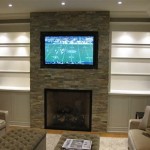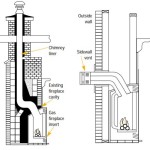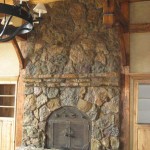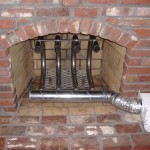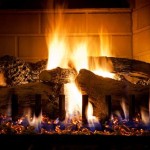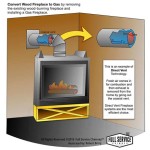Gas Fireplace Wood: Aesthetics, Functionality, and Safe Use
This article explores the use of wood, specifically artificial wood logs, in gas fireplaces. It will cover the aesthetic benefits, functional considerations, safety aspects, and various types of gas fireplace logs available to consumers. The focus will be on providing a comprehensive understanding of this popular fireplace feature, enabling informed decisions regarding selection, installation, and maintenance.Gas fireplaces offer a convenient and efficient alternative to traditional wood-burning fireplaces. They provide instant heat, require less maintenance, and eliminate the need for firewood storage. However, many people appreciate the visual appeal of a wood-burning fire. To bridge this gap, manufacturers offer gas fireplaces with artificial wood logs, recreating the ambiance of a natural fire without the associated labor and mess.
These artificial logs are typically made from ceramic or refractory cement materials. They are designed to withstand high temperatures and are arranged within the fireplace to create a realistic-looking fire bed. The gas flames are directed around and through the logs, producing a flickering effect that mimics the movement of real flames. While the logs themselves do not burn, their placement and design contribute significantly to the overall aesthetic of the fireplace.
Choosing the right gas fireplace logs involves considering several factors, including the size and style of the fireplace, the desired aesthetic, and the type of gas being used (natural gas or propane). Understanding the different types of logs, their materials, and proper installation techniques is crucial for ensuring safe and efficient operation.
Aesthetic Considerations: Recreating the Natural Look
The primary purpose of gas fireplace logs is to enhance the visual appeal of the fireplace. Manufacturers invest significant effort in creating logs that accurately resemble real wood, from the texture of the bark to the nuanced coloring and grain patterns. Different types of wood, such as oak, birch, and maple, are often replicated, allowing homeowners to choose a style that complements their existing décor.
The level of realism can vary considerably between different log sets. Higher-quality sets often feature intricate detailing and hand-painted finishes to achieve a more authentic look. The arrangement of the logs is also important. A well-arranged log set will create a natural-looking fire bed with varying levels of openness, allowing the flames to flicker and dance realistically.
Beyond the logs themselves, the inclusion of other decorative elements, such as embers, twigs, and pine cones, can further enhance the realism of the fireplace. These accessories are typically made from similar heat-resistant materials and are designed to complement the logs. The placement of these elements can significantly impact the overall aesthetic, adding depth and visual interest to the fire display.
Furthermore, the flame pattern of the gas fireplace plays a crucial role in the overall aesthetic. Modern gas fireplaces often incorporate advanced burner technology to create more realistic and dynamic flame patterns. These patterns mimic the way real flames move and flicker, adding to the immersive experience.
Functional Aspects: Heat Output and Efficiency
While the primary function of gas fireplace logs is aesthetic, they also play a role in heat distribution and efficiency. The logs are designed to radiate heat into the room, contributing to the overall warming effect of the fireplace. The material and arrangement of the logs can influence how effectively heat is distributed.
Ceramic logs, for example, are known for their excellent heat retention properties. They absorb heat from the gas flames and radiate it slowly into the surrounding area, providing a consistent and comfortable warmth. Refractory cement logs, on the other hand, tend to heat up more quickly but may not retain heat as well as ceramic logs.
The arrangement of the logs can also affect heat distribution. A more open arrangement allows for greater airflow around the logs, which can improve heat convection. However, a more tightly packed arrangement may result in more radiant heat being directed forward into the room.
The overall efficiency of a gas fireplace is determined by several factors, including the burner design, the venting system, and the insulation of the firebox. While the logs themselves do not directly impact the energy efficiency rating, they contribute to the overall effectiveness of the fireplace in heating the room.
It is important to choose a log set that is appropriately sized for the fireplace to ensure optimal heat output and efficiency. Using logs that are too large can restrict airflow and reduce the effectiveness of the burner. Conversely, using logs that are too small may result in uneven heat distribution and a less visually appealing fire.
The type of gas used, whether natural gas or propane, also influences the heat output of the fireplace. Propane typically produces more heat per unit than natural gas, so a propane-fueled fireplace may generate more warmth than a similar natural gas model.
Safety Considerations: Installation, Maintenance, and Prevention
Safety is paramount when using any type of fireplace, including gas fireplaces with artificial wood logs. Proper installation, regular maintenance, and adherence to safety guidelines are essential for preventing accidents and ensuring safe operation.
Incorrect installation of gas fireplace logs can lead to dangerous situations, such as gas leaks or carbon monoxide poisoning. It is crucial to follow the manufacturer's instructions carefully and to have the installation performed by a qualified professional. The logs must be positioned correctly to ensure proper airflow and to prevent interference with the burner or pilot light.
Regular maintenance is essential for ensuring the safe and efficient operation of a gas fireplace. This includes cleaning the logs periodically to remove dust and soot, inspecting the burner and pilot light for any signs of damage or malfunction, and checking the venting system for obstructions. A qualified technician should perform a thorough inspection of the fireplace at least once a year.
Carbon monoxide detectors should be installed in the home, particularly near sleeping areas, to alert residents to the presence of this odorless and dangerous gas. The detectors should be tested regularly to ensure they are functioning properly. If a carbon monoxide alarm sounds, it is important to evacuate the premises immediately and contact emergency services.
It is crucial to never place any flammable materials, such as paper, clothing, or furniture, near the fireplace. The heat from the flames can ignite these materials, causing a fire. Children and pets should be supervised closely when the fireplace is in operation to prevent burns or other injuries.
Furthermore, it is important to ensure that the fireplace is properly vented to the outside. Blocked or damaged vents can cause carbon monoxide to build up inside the home. The venting system should be inspected regularly to ensure it is clear of obstructions and in good working order. Never attempt to operate a gas fireplace with a blocked or damaged vent.
Finally, it is crucial to be aware of the signs of a gas leak, such as a rotten egg smell or a hissing sound near the fireplace. If a gas leak is suspected, it is important to shut off the gas supply immediately and contact the gas company or a qualified technician. Do not attempt to ignite any flames or use any electrical devices, as this could trigger an explosion.
By adhering to these safety guidelines, homeowners can enjoy the warmth and ambiance of a gas fireplace with artificial wood logs while minimizing the risk of accidents and ensuring the safety of their families.
In summary, gas fireplace wood logs offer a practical and aesthetically pleasing alternative to traditional wood-burning fires. They provide the visual appeal of a real fire without the associated mess and maintenance. Understanding the different types of logs, their functional aspects, and safety considerations is crucial for making an informed decision and ensuring safe and efficient operation.

Fireplaces Inserts Wood Gas Fireplace Xtrordinair

Wood Fireplaces Gas Conversion That Counts
Can I Convert My Wood Burning Fireplace To Gas Woodlanddirect Com
Converting A Wood Burning Fireplace Into Gas Heat Glo

Gas Log Fireplaces Jetmaster

Procom 24 In Vented Natural Gas Fireplace Log Set Wan24n 2 The Home Depot

The Best Gas Log Sets For 2024 Fireplaces Direct Learning Center

Want To Convert Gas Wood Fireplace Full Service Chimney

Enviro Inbuilt Gas Log Fire Fireplace Range Living

Pros And Cons Of Gas Wood Electric Fireplaces Tripod International

